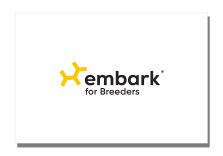Cerebellar Hypoplasia
Known as the "oldest" (even reptiles and more ancient species have them!) part of the brain, the cerebellum fine-tunes motor signals from the brain to the muscles, allowing for balance and coordination. When the cerebellum does not function properly, dogs become uncoordinated and do not have the ability to perform fine motor skills.
-
Signs and symptoms
Signs of cerebellar disease include: dogs have an uncoordinated gait (ataxia) with stilted "toy soldier" leg movements. They can display "intention tremors," where a stretched out limb or head shakes more and more violently as it approaches its target. At rest, dogs sometimes display a "truncal sway;" their spinal muscles have lost their fine-tuning, pulling the spine (and everything attached to it) back and forth in a struggle to maintain balance. The muscles of the eyes have also lost this fine-tuning, leading to a rhythmic eye flicking (nystagmus).
Affected pups are abnormal from birth and, even before they open their eyes, show signs of cerebellar disease including intention tremors and truncal sway. As they begin to walk they show uncoordinated gait and poor balance of cerebellar disease. -
Diagnosis
Unless a genetic basis is suspected due to the age, breed, or history of the dog, diagnostics must be performed to rule out infectious, inflammatory, or neoplastic causes.
-
Treatment
There is no treatment for this disorder. Certain medications may be prescribed to control symptoms.
-
What to do if your dog is at risk
Actions
- Talk to your vet about your dog’s cerebellar hypoplasia result so you can plan appropriate care and monitoring.
- Signs such as unsteady movement or wobbliness on their feet usually appear when puppies begin to walk and persist throughout life.
- Keep your dog’s environment calm and consistent. Use rugs or mats to prevent slipping and help them move safely around the home.
- With supportive care, many dogs adapt well and enjoy daily life; however, those with more severe symptoms may need extra help to stay comfortable and safe.
-
Genetic Information
Cerebellar hypoplasia (CH) is a developmental disease that can arise from a genetic mutation or from environmental insults during development (in utero infection with canine parvovirus being one of the most common, nongenetic causes of cerebellar disease). It has a known genetic basis in the Eurasier, where the condition has been mapped to a mutation in the VLDLR gene.
This disease is inherited in an autosomal recessive manner, meaning that affected dogs must have two copies of the mutation to show clinical signs.
Gene names:
VLDLR ‐ chr
Inheritance type:
recessive
Citations:
-
Breeds affected
This health condition affects the following breeds
Learn about your dog’s unique genetic health
Dog owners
Breed identification, health and trait insights, personalized care recommendations, and the world’s first canine relative finder—all in one leading dog DNA test.
Learn about the report for dog ownersShop the test
Breeding programs
Embark’s test for breeding programs is one comprehensive DNA test designed with your needs in mind.
Learn about the report for breedersShop the test












